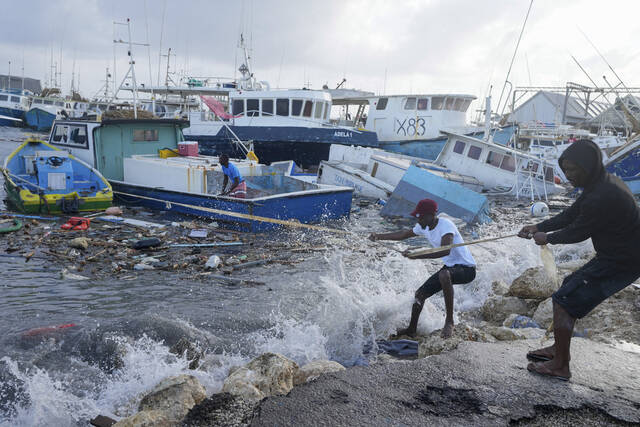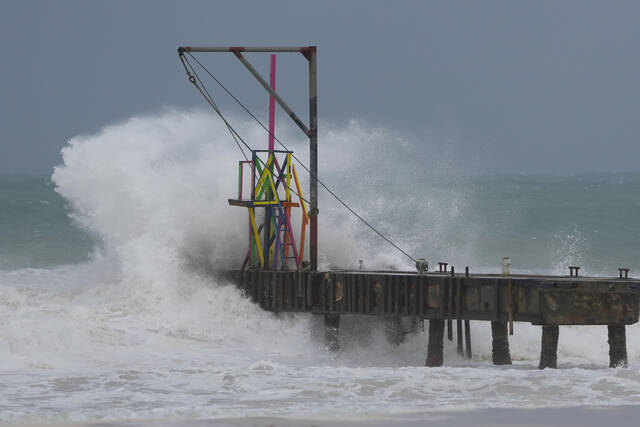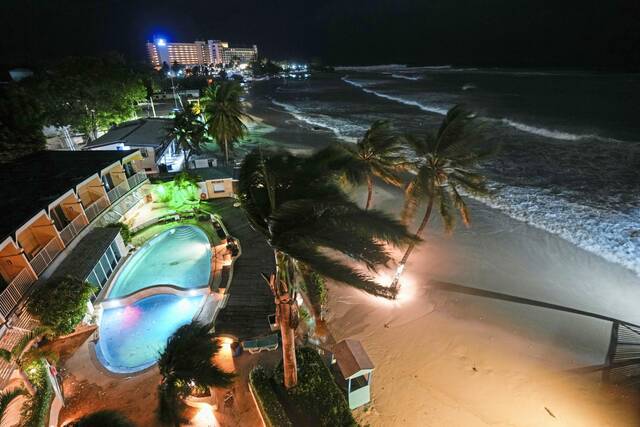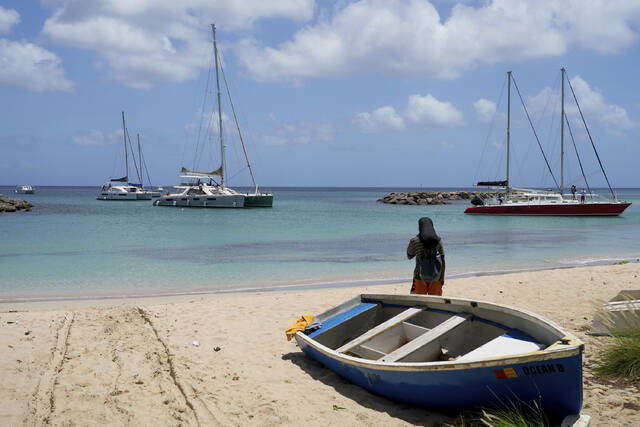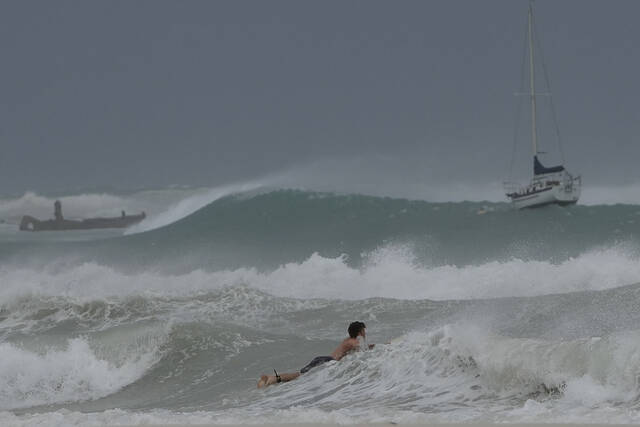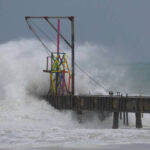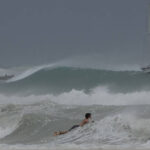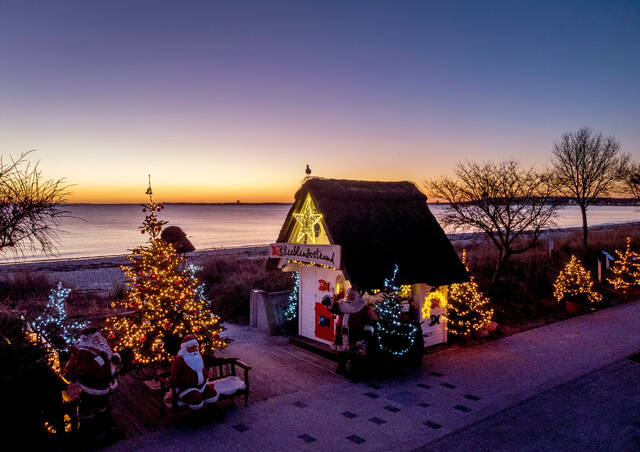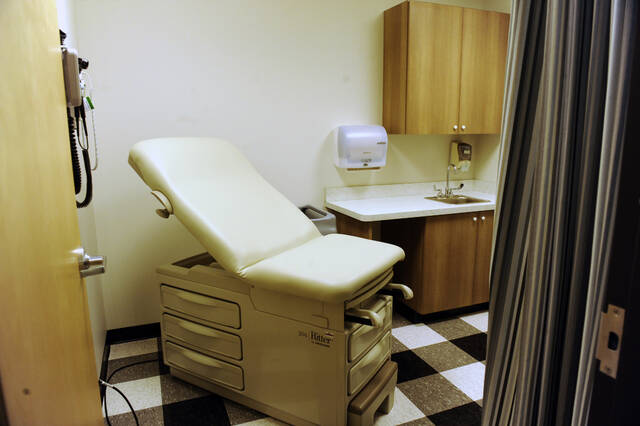SAN JUAN, Puerto Rico — Hurricane Beryl has strengthened to Category 5 status as it crosses islands in the southeastern Caribbean.
Beryl ripped off doors, windows and roofs in homes across the southeastern Caribbean on Monday after making landfall on the island of Carriacou in Grenada as the earliest Category 4 storm in the Atlantic, fueled by its record warm waters.
Grenada’s Prime Minister Dickon Mitchell said late Monday that one person had died and authorities had not been able to assess the situation on the islands of Carriacou and Petite Martinique. There were initial reports of major damage but communications were largely down.
Late Monday, Beryl’s wind increased to 160 mph. Fluctuations in strength were likely in the coming days.
"The early season is behaving like the peak of the season."
Hurricane Expert @DrRickKnabb has the latest on #Beryl: pic.twitter.com/m5rm8Sb5XP— The Weather Channel (@weatherchannel) July 1, 2024
Beryl was about 510 miles east-southeast of Isla Beata in the Dominican Republic and was moving west-northwest at 22 mph. It was forecast to pass near Jamaica on Wednesday.
A hurricane warning was in effect for Jamaica, and a tropical storm warning for the entire southern coast of Hispaniola, an island shared by Haiti and the Dominican Republic.
“Beryl is expected to remain an extremely dangerous major hurricane as its moves over the eastern Caribbean,” the National Hurricane Center said.
Grenada officials had to evacuate patients to a lower floor after hospital roof was damaged, he said.
“There is the likelihood of even greater damage,” he told reporters. “We have no choice but to continue to pray.”
On Monday afternoon, Beryl was about 65 miles northwest of the island of Grenada, moving west-northwest at 20 mph.
In Barbados, officials received more than a dozen reports of roof damage, fallen trees and downed electric posts across the island, said Kerry Hinds, emergency management director. Wilfred Abrahams, minister of home affairs and information, said drones — which are faster than crews fanning across the island — would assess damage once Beryl passes.
A tropical storm warning was in effect for St. Lucia and Martinique. A tropical storm watch was issued for Haiti’s entire southern coast, and from Punta Palenque in the Dominican Republic west to the border with Haiti. A hurricane watch was issued for Jamaica.
Forecasters warned of a life-threatening storm surge of up to 9 feet in areas where Beryl made landfall, with 3 to 6 inches of rain for Barbados and nearby islands and possibly 10 inches in some areas, especially in Grenada and the Grenadines.
The storm was expected to weaken slightly over the Caribbean Sea on a path that would take it just south of Jamaica and later toward Mexico’s Yucatan Peninsula as a Category 1.
“Beryl is forecast to remain a significant hurricane during its entire trek across the Caribbean region,” the National Hurricane Center said.
#Hurricane #Beryl continues to strengthen and how has max winds of 155 mph – the earliest Atlantic calendar year hurricane this strong on record. The only other July hurricane with max winds 155+ mph is Hurricane Emily (2005), which topped out as a Cat. 5 with 160 mph winds. pic.twitter.com/r2DfZbu073
— Philip Klotzbach (@philklotzbach) July 1, 2024
The last strong hurricane to hit the southeast Caribbean was Hurricane Ivan 20 years ago, which killed dozens of people in Grenada.
On Monday afternoon, officials received “reports of devastation” from Carriacou and surrounding islands, said Terence Walters, Grenada’s national disaster coordinator. Prime Minister Dickon Mitchell said he would travel to Carriacou as soon as it’s safe, noting there’s been an “extensive” storm surge.
Grenada officials had to evacuate patients to a lower floor after hospital roof was damaged, he said.
“There is the likelihood of even greater damage,” he told reporters. “We have no choice but to continue to pray.”
In Barbados, Wilfred Abrahams, minister of home affairs and information, said drones — which are faster than crews fanning across the island — would assess damage once Beryl passes.
Historic Hurricane
Beryl strengthened from a tropical depression to a major hurricane in just 42 hours — a feat accomplished only six other times in Atlantic hurricane history, and with Sept. 1 as the earliest date, according to hurricane expert Sam Lillo.
It also was the earliest Category 4 Atlantic hurricane on record, besting Hurricane Dennis, which became a Category 4 storm on July 8, 2005.
Beryl amassed its strength from record warm waters that are hotter now than they would be at the peak of hurricane season in September, said hurricane specialist and storm surge expert Michael Lowry.
Beryl also marked the farthest east that a hurricane has formed in the tropical Atlantic in June, breaking a record set in 1933, according to Philip Klotzbach, Colorado State University hurricane researcher.
On Sunday night, Beryl formed a new eye, or center, something that usually weakens a storm slightly as it grows larger in area. Experts say it’s now back to strengthening.
Jaswinderpal Parmar of Fresno, California, who was among the thousands who traveled to Barbados for Saturday’s Twenty20 World Cup cricket final, said he and his family were now stuck there with scores of other fans, their flights canceled on Sunday.
He said by phone that it’s the first time he has experienced a hurricane — he and his family have been praying, as well as taking calls from concerned friends and family as far away as India.
“We couldn’t sleep last night,” Parmar, 47, said.
About a dozen of the ECMWF ensembles today suggest still Hurricane #Beryl may make more of a significant NE turn this coming weekend into TX or LA. Personally think this remains unlikely but definitely should not discount it yet. All comes down to the high pressure placement.… pic.twitter.com/UunkhIU5tQ
— Noah Bergren (@NbergWX) July 1, 2024
Looking ahead
Even as Beryl bore down on the southeast Caribbean, government officials warned about a cluster of thunderstorms mimicking the hurricane’s path that have a 70% chance of becoming a tropical depression.
“There’s always a concern when you have back-to-back storms,” Lowry said. “If two storms move over the same area or nearby, the first storm weakens the infrastructure, so the secondary system doesn’t need to be as strong to have serious impacts.”
Beryl is the second named storm in the Atlantic hurricane season, which runs from June 1 to Nov. 30. Earlier this month, Tropical Storm Alberto made landfall in northeast Mexico and killed four people.
The National Oceanic and Atmospheric Administration predicts the 2024 hurricane season is likely to be well above average, with between 17 and 25 named storms. The forecast calls for as many as 13 hurricanes and four major hurricanes.
An average Atlantic hurricane season produces 14 named storms, seven of them hurricanes and three major hurricanes.


